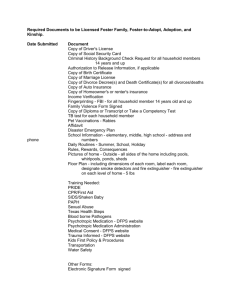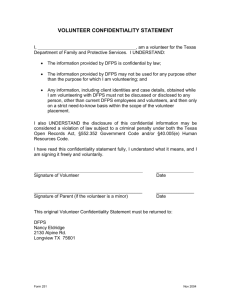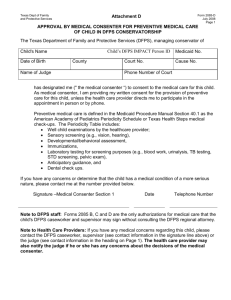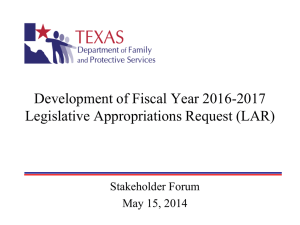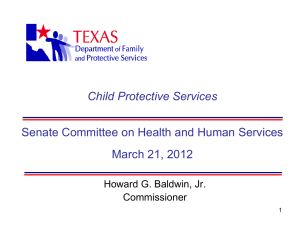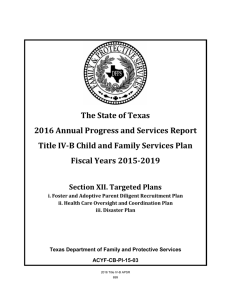roadmap for cps litigators
advertisement
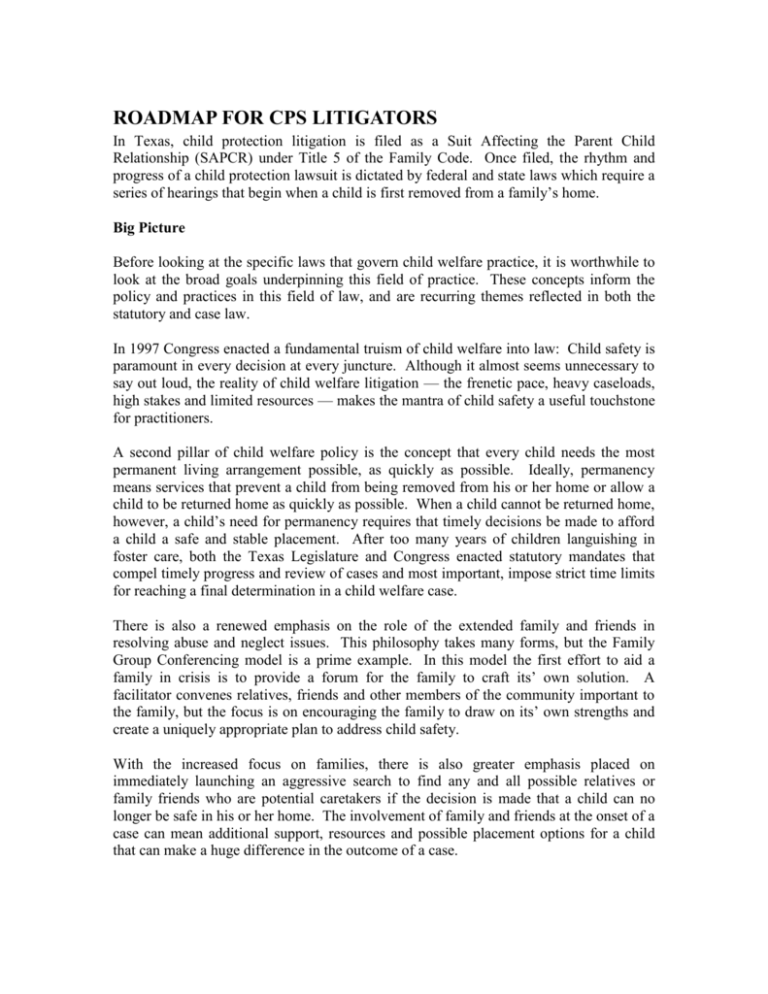
ROADMAP FOR CPS LITIGATORS In Texas, child protection litigation is filed as a Suit Affecting the Parent Child Relationship (SAPCR) under Title 5 of the Family Code. Once filed, the rhythm and progress of a child protection lawsuit is dictated by federal and state laws which require a series of hearings that begin when a child is first removed from a family’s home. Big Picture Before looking at the specific laws that govern child welfare practice, it is worthwhile to look at the broad goals underpinning this field of practice. These concepts inform the policy and practices in this field of law, and are recurring themes reflected in both the statutory and case law. In 1997 Congress enacted a fundamental truism of child welfare into law: Child safety is paramount in every decision at every juncture. Although it almost seems unnecessary to say out loud, the reality of child welfare litigation — the frenetic pace, heavy caseloads, high stakes and limited resources — makes the mantra of child safety a useful touchstone for practitioners. A second pillar of child welfare policy is the concept that every child needs the most permanent living arrangement possible, as quickly as possible. Ideally, permanency means services that prevent a child from being removed from his or her home or allow a child to be returned home as quickly as possible. When a child cannot be returned home, however, a child’s need for permanency requires that timely decisions be made to afford a child a safe and stable placement. After too many years of children languishing in foster care, both the Texas Legislature and Congress enacted statutory mandates that compel timely progress and review of cases and most important, impose strict time limits for reaching a final determination in a child welfare case. There is also a renewed emphasis on the role of the extended family and friends in resolving abuse and neglect issues. This philosophy takes many forms, but the Family Group Conferencing model is a prime example. In this model the first effort to aid a family in crisis is to provide a forum for the family to craft its’ own solution. A facilitator convenes relatives, friends and other members of the community important to the family, but the focus is on encouraging the family to draw on its’ own strengths and create a uniquely appropriate plan to address child safety. With the increased focus on families, there is also greater emphasis placed on immediately launching an aggressive search to find any and all possible relatives or family friends who are potential caretakers if the decision is made that a child can no longer be safe in his or her home. The involvement of family and friends at the onset of a case can mean additional support, resources and possible placement options for a child that can make a huge difference in the outcome of a case. These tenets of child welfare practice serve as an important backdrop to the complex array of state and federal statutes, rules and case law that govern this field of practice. How can an attorney representing DFPS maintain a good working knowledge of all the operative laws and issues that can arise in this field? Without question, nothing can replace returning to the source, whether it is the Texas Family Code, the Texas Rules of Civil Practice, the Texas Rules of Evidence, the Texas Administrative Code, federal laws and local rules of practice, and developing case law. These authorities are without a doubt the ballast of a child welfare attorneys’ legal arsenal. What the Practice Guide offers is a quick reference to aid in spotting issues and finding applicable laws, a frame of reference for additional research and a collection of practice tools. For a quick overview of the broad terrain encompassed by this Practice Guide, read on. NOTE: The Department of Family & Protective Services (DFPS) is the legal entity that is generally named as a party in a lawsuit, but it is the Child Protective Services (CPS) division of DFPS that has direct responsibility for investigating and protecting children from abuse and neglect. For purposes of the Practice Guide, DFPS and CPS are used interchangeably to refer to CPS, unless otherwise specified. Section 1 BEFORE FILING SUIT Before a child is ever removed from a family, DFPS has many options that can be used to bolster child safety sufficiently to obviate the need for removal. Some are informal arrangements such as a parental child safety placement, a temporary arrangement a parent makes for a child to stay with a relative or friend of the family. Other options, such as an Order to Participate in Services, require court intervention. Attorneys for the agency should be familiar with the full array of options, in order to evaluate and advise CPS on individual cases. See Court Orders In Aid of Investigation, Alternatives to Removal. Similarly, knowing when and how the Fourth Amendment applies in CPS practice is crucial, as is being grounded in the ethics that govern this practice area. See The Fourth Amendment & CPS Practice and Ethical Issues in Litigation. Section 2 STATUTORY HEARINGS Representing the agency in the regimen of statutory hearings that begin when a child must be removed from his or her home constitutes a core function for DFPS attorneys. Understanding the purpose, the scope and the statutes that govern these hearings is essential. A Quick Look at the Life of a Child Protection Suit offers a quick overview of the statutory scheme. For a detailed look at the progression of statutory hearings consult the series of Hearing Guides and Every Hearing Checklist. Section 3 LITIGATION ESSENTIALS The familiar building blocks in a civil litigator’s world – jurisdiction, service of process and default judgments – present unique hazards and hurdles in the child welfare realm, whether DFPS seeks a temporary child protection order or a final order terminating parental rights. Identifying the proper parties, sorting out paternity, ensuring mandatory appointments of counsel are made and child support orders entered all require special attention in every lawsuit DFPS files. See Jurisdiction, Parties, Paternity Questions & Solutions, Appointments, Service of Process, Default Judgments and Child Support. NOTE: HOT DOCS is a licensed software program for CPS pleadings available to County and District Attorneys who represent DFPS. To request HOT DOCS, contact the Office of General Counsel at (512) 438-5606. Section 4 DISCOVERY Civil litigation discovery rules apply to child welfare litigation, but rules governing confidentiality, as well as other unique issues require special discovery strategies. See Confidentiality, Objections, Privileges, Subpoenas, Requests for Disclosure, Requests for Admission, Interrogatories, Requests for Production of Documents, Depositions, Requests for Physical and Mental Exams, Discovery from Non-parties, Experts, and Enforcement. Section 5 TERMINATION GROUNDS With more than twenty separate grounds for termination of parental rights and constantly developing case law, keeping abreast of the current case law is challenging. This case law compendium offers a succinct summary of the individual grounds and case law construing each. See Burden of Proof, Termination Grounds. Section 6 EVIDENCE The inherent difficulty of proving the many forms of child abuse and neglect, acts that are frequently witnessed only by a child victim, makes having a firm grasp of the rules of evidence critical to success. See Standards of Proof, Evidentiary Issues from “A” to “Z,” Child Witnesses, and Expert Witness Testimony. Section 7 JURY TRIALS When a jury is the finder of fact in a child protection suit, the attorney representing DFPS must not only be armed with the rules and procedures governing jury trials but also be prepared to work effectively to impact the make up of the jury, the focus of the panel’s deliberations and of course, the verdict. See Authority, Jury Demand, Jury Shuffle, Pre -Trial, Motion in Limine, Jury Instructions, Voir Dire, Jury Charge, and After the Verdict. Section 8 DE NOVO HEARINGS & POST TRIAL STRATEGIES An increasing number of appeals and expedited time frames make it imperative that attorneys representing DFPS be savvy about laying the foundation for an appeal and about post-trial protocols. See The DFPS Appellate Unit, Setting the Stage for an Appeal, De Novo Hearings, Post Trial Wrap Up, Time Frames and Procedures. Section 9 SPECIAL ISSUES The increasing complexity of this field of practice is in part the result of the growing awareness of the many needs foster children have beyond protection from child abuse and neglect. Even those issues that arise infrequently are important enough that it is essential that lawyers for the agency be able to spot the issue and find the applicable authority or policy. For example: Every placement is potentially impacted by federal and state laws restricting the use of race and ethnicity in the placement process, and, if an out of state placement is planned, the Interstate Compact on the Placement of Children (“ICPC”); See Placements. Every foster child must have a court authorized person to consent to medical care and issues such as administration of psychotropic medications, participation in drug research programs, abortion, do not resuscitate orders and organ donation all merit careful legal scrutiny; See Health Care A child with Native American heritage may be an “Indian child” subject to the Indian Child Welfare Act, which imposes statutory placement preferences for Indian children, a higher burden of proof, mandates on how any restriction of parental rights must occur, including how a relinquishment can be taken, and many other special legal requirements; See Indian Child Welfare Act. If an infant is voluntarily left at a designated place, the “Baby Moses” laws may apply and alter the legal procedures significantly; See Baby Moses. If a foreign born child comes into care, DFPS may be required to give notice to the foreign consul, the child may need legal assistance in obtaining immigration status and if repatriation is considered, the legal ramifications must be considered; See Citizenship & Immigration Status. One method for resolving a CPS case, or narrowing the issues to be litigated, is mediation. Increasingly used across the state, mediation is most successful when attorneys are knowledgeable, prepared and skilled; See Mediation. Section 10 TRIAL NOTEBOOK Each of the forms, checklists and quick reference tools in this collection has the “battletested” seal of approval from experienced DFPS attorneys. The notebook can be tailored and tweaked to create a trial notebook that best suits a litigator’s needs for a specific trial. Section 11 TOOLS Sometimes finding what you need to get the job done takes far too much time. This collection of forms, sample letters, regulations, checklists, and other useful information that DFPS lawyers frequently refer to, organized by subject heading, should save time so that you can focus on the merits of your case. Section 12 RESOURCES There are many resources a practitioner can tap into on every subject that touches this field of practice. Particularly for newcomers to this field, familiarity with the CPS organization and the unique acronyms and vocabulary used in this realm will make effective representation much easier. See Child Welfare Contacts, Glossary of Terms for Child Welfare Attorneys, Common Child Protective Services Acronyms and A Look Inside CPS.
